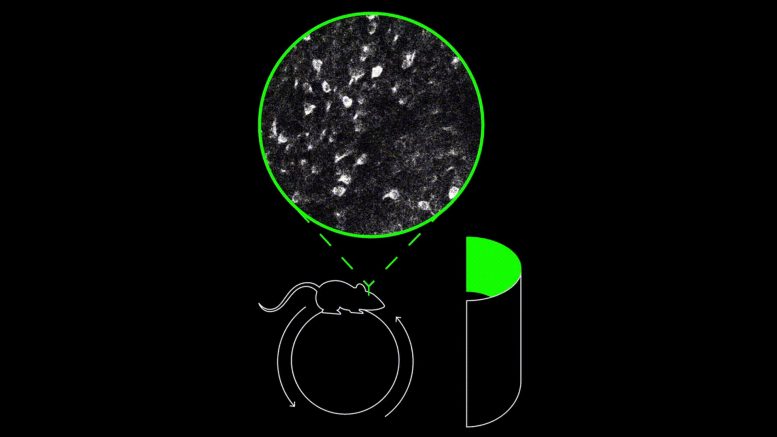Researchers at the University of Utah Health found that "time cells" in mice adapt to learning timed tasks, a discovery that could aid early Alzheimer's detection by monitoring changes in a key brain region.
Our perception of time is crucial to our interaction with and understanding of the world around us. Whether we're engaging in a conversation or driving a car, we need to remember and gauge the duration of events—a complex but largely unconscious calculation running constantly beneath the surface of our thoughts.
Now, researchers at the University of Utah Health have found that, in mice, a specific population of "time cells" is essential for learning complex behaviors where timing is critical. Like the second hand of a clock, time cells fire in sequence to map out short periods of time.
But time cells aren't just a simple clock, the researchers found—as animals learn to distinguish between differently timed events, the pattern of time cell activity changes to represent each pattern of events differently. The discovery could ultimately aid in the early detection of neurodegenerative diseases, such as Alzheimer's, that affect the sense of time.
The new study is published in Nature Neuroscience.
Mouse code
By combining a complex time-based learning task with advanced brain imaging, researchers were able to watch patterns of time cell activity become more complex as the mice learned. The researchers first set up a trial where learning the differences in the timing of events was critical. To get a reward, mice had to learn to distinguish between patterns of an odor stimulus that had variable timing, as if they were learning a very simple form of Morse code.
Left to right: James Heys, PhD; Erin Bigus; Hyunwoo Lee, PhD. Credit: Left to right: Charlie Ehlert, Matthieu Couriol, Kyung Jennifer Lee.
Before and after the mice learned, the researchers used cutting-edge microscopy to watch individual time cells fire in real-time. At first, their time cells responded in the same way to every pattern of odor stimulus. But as they learned the differently timed patterns of stimulus, the mice developed different patterns of time cell activity for each pattern of events.
Notably, during trials that the mice got wrong, the researchers could see that their time cells had often fired in the wrong order, suggesting that the right sequence of time cell activity is critical for performing time-based tasks. "Time cells are supposed to be active at specific moments during the trial," said Hyunwoo Lee, PhD, a postdoctoral fellow in neurobiology in the Spencer Fox Eccles School of Medicine at the University of Utah and co-first author on the study. "But when the mice made mistakes, that selective activity became messy."
Not just a stopwatch
Surprisingly, time cells play a more complicated role than merely tracking time, said Erin Bigus, graduate research assistant in neurobiology and co-first author on the study. When the researchers temporarily blocked the activity of the brain region that contains time cells, the medial entorhinal cortex (MEC), mice could still perceive and even anticipate the timing of events. But they couldn't learn complex time-related tasks from scratch. "The MEC isn't acting like a really simple stopwatch that's necessary to track time in any simple circumstance," Bigus said. "Its role seems to be in actually learning these more complex temporal relationships."
The researchers used advanced brain imaging to watch neurons fire before and after mice learned. Credit: Heys Lab / University of Utah Health
Intriguingly, prior research on the MEC found that it's also involved in learning spatial information and building "mental maps." In the new study, researchers noticed that the patterns of brain activity that occur while learning time-based tasks show some similarities to previously observed patterns involved in spatial learning; aspects of both patterns persist even while an animal isn't actively learning.
While more research is needed, these results suggest that the brain could process space and time in fundamentally similar ways, according to the researchers. "We believe that the entorhinal cortex might serve a dual purpose, acting both as an odometer to track distance and as a clock to track elapsed time," said James Heys, PhD, assistant professor in neurobiology and the senior author on the study.
"These are the first areas of the brain to be affected by neurodegenerative diseases like Alzheimer's. We are interested in exploring whether complex timing behavior tasks could be a useful way to detect the early onset of Alzheimer's disease." – James Heys
Learning how the brain processes time could ultimately aid in the detection of neurodegenerative diseases such as Alzheimer's, the researchers say. The MEC is one of the first areas of the brain that Alzheimer's affects, hinting that complex timing tasks could potentially be a way to catch the disease early.
Reference: "Medial entorhinal cortex mediates learning of context-dependent interval timing behavior" by Erin R. Bigus, Hyun-Woo Lee, John C. Bowler, Jiani Shi and James G. Heys, 14 June 2024, Nature Neuroscience.
DOI: 10.1038/s41593-024-01683-7
The study was funded by the U.S. National Science Foundation, the Whitehall Foundation, the Brain and Behavior Research Foundation, the National Institute of Mental Health, the National Research Foundation of Korea, and the University of Utah.
News
New study suggests a way to rejuvenate the immune system
Stimulating the liver to produce some of the signals of the thymus can reverse age-related declines in T-cell populations and enhance response to vaccination. As people age, their immune system function declines. T cell [...]
Nerve Damage Can Disrupt Immunity Across the Entire Body
A single nerve injury can quietly reshape the immune system across the entire body. Preclinical research from McGill University suggests that nerve injuries may lead to long-lasting changes in the immune system, and these [...]
Fake Science Is Growing Faster Than Legitimate Research, New Study Warns
New research reveals organized networks linking paper mills, intermediaries, and compromised academic journals Organized scientific fraud is becoming increasingly common, ranging from fabricated research to the buying and selling of authorship and citations, according [...]
Scientists Unlock a New Way to Hear the Brain’s Hidden Language
Scientists can finally hear the brain’s quietest messages—unlocking the hidden code behind how neurons think, decide, and remember. Scientists have created a new protein that can capture the incoming chemical signals received by brain [...]
Does being infected or vaccinated first influence COVID-19 immunity?
A new study analyzing the immune response to COVID-19 in a Catalan cohort of health workers sheds light on an important question: does it matter whether a person was first infected or first vaccinated? [...]
We May Never Know if AI Is Conscious, Says Cambridge Philosopher
As claims about conscious AI grow louder, a Cambridge philosopher argues that we lack the evidence to know whether machines can truly be conscious, let alone morally significant. A philosopher at the University of [...]
AI Helped Scientists Stop a Virus With One Tiny Change
Using AI, researchers identified one tiny molecular interaction that viruses need to infect cells. Disrupting it stopped the virus before infection could begin. Washington State University scientists have uncovered a method to interfere with a key [...]
Deadly Hospital Fungus May Finally Have a Weakness
A deadly, drug-resistant hospital fungus may finally have a weakness—and scientists think they’ve found it. Researchers have identified a genetic process that could open the door to new treatments for a dangerous fungal infection [...]
Fever-Proof Bird Flu Variant Could Fuel the Next Pandemic
Bird flu viruses present a significant risk to humans because they can continue replicating at temperatures higher than a typical fever. Fever is one of the body’s main tools for slowing or stopping viral [...]
What could the future of nanoscience look like?
Society has a lot to thank for nanoscience. From improved health monitoring to reducing the size of electronics, scientists’ ability to delve deeper and better understand chemistry at the nanoscale has opened up numerous [...]
Scientists Melt Cancer’s Hidden “Power Hubs” and Stop Tumor Growth
Researchers discovered that in a rare kidney cancer, RNA builds droplet-like hubs that act as growth control centers inside tumor cells. By engineering a molecular switch to dissolve these hubs, they were able to halt cancer [...]
Platelet-inspired nanoparticles could improve treatment of inflammatory diseases
Scientists have developed platelet-inspired nanoparticles that deliver anti-inflammatory drugs directly to brain-computer interface implants, doubling their effectiveness. Scientists have found a way to improve the performance of brain-computer interface (BCI) electrodes by delivering anti-inflammatory drugs directly [...]
After 150 years, a new chapter in cancer therapy is finally beginning
For decades, researchers have been looking for ways to destroy cancer cells in a targeted manner without further weakening the body. But for many patients whose immune system is severely impaired by chemotherapy or radiation, [...]
Older chemical libraries show promise for fighting resistant strains of COVID-19 virus
SARS‑CoV‑2, the virus that causes COVID-19, continues to mutate, with some newer strains becoming less responsive to current antiviral treatments like Paxlovid. Now, University of California San Diego scientists and an international team of [...]
Lower doses of immunotherapy for skin cancer give better results, study suggests
According to a new study, lower doses of approved immunotherapy for malignant melanoma can give better results against tumors, while reducing side effects. This is reported by researchers at Karolinska Institutet in the Journal of the National [...]
Researchers highlight five pathways through which microplastics can harm the brain
Microplastics could be fueling neurodegenerative diseases like Alzheimer's and Parkinson's, with a new study highlighting five ways microplastics can trigger inflammation and damage in the brain. More than 57 million people live with dementia, [...]























